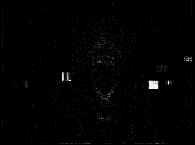|
Error Blocks Measured with Added Motion Energy Parameter
Error Blocks are defined in ANSI T1.801.02-1996 as "A form of block distortion where one or more blocks in the image bear no resemblance to the current or previous scene and often contrast greatly with adjacent blocks."
The images and graph below illustrate how the added motion energy parameter in ANSI T1.801.03-1996 can be used to detect and quantify the perceptual effects of error blocks. Two consecutive input images (frame 1 and frame 2) and their corresponding output images are displayed. The input and output temporal information (TI) images were computed by subtracting frame 1 from frame 2. Increasing values of TI, or motion, are shown as whiter areas in the TI images. The sudden occurrence of the error blocks in output frame number 2 produces a relatively large amount of added TI. The graph demonstrates how the appearance and disappearance of an error block causes spikes, or sudden increases, in the TI values. The perceptibility of error blocks is related to the logarithmic ratio of the output TI value divided by the input TI value. In other words, error blocks become more noticeable in low motion scenes than high motion scenes.

| Input |
 |
- |
 |
= |
 |
| |
Frame 2 |
|
Frame 1 |
|
TI |
| Output |
 |
- |
 |
= |
 |
|
